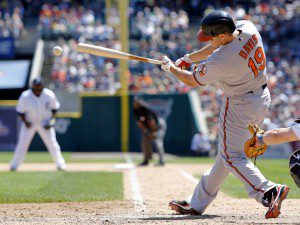
Yesterday I said I liked the Royals to earn one of the wild-card spots because they play great defense and have the best bullpen in the majors and in recent history. But I overlooked one important factor: Ned Yost. Of all the AL teams in contention for a playoff berth, Yost is by far the most tactically challenged (Ron Washington is not far behind). Ranging from his obsession with the bunt to putting players with OBPs less than .300 in the number-two spot in the lineup to never using George Kottaras in pinch-hit situations to continually using Kelvin Herrera in high-leverage situations, his ineptness at tactics has no bounds. Tuesday’s game was no different.
With a 3-1 lead in the seventh, he allowed Herrera to pitch, even though Luke Hochevar, one of the best setup men, was available. Normal (typical) convention says relievers can only pitch one inning at a time, which is completely rubbish. This is a playoff game and it should be managed as such. An argument could be made that, as a reliever, Hochevar hasn’t been stretched out and is incapable to throw more than one inning. My retort is last year Hochevar was in the Royals starting rotation and has thrown nearly 200 innings the past two seasons. So in the seventh inning, Herrera goes on to allow the Indians to tie the game. Then in the eighth, when the game is tied, Wade Davis comes in and promptly gives up a run. Then, with Royals losing, Hochevar finally makes an appearance — when they’re losing!
Whether it’s letting Jeremy Guthrie pitch into the eighth inning in a winnable game Sunday against the Detroit Tigers so Guthrie, not the Royals, could win the game or pinch-hitting Carlos Pena for Jarrod Dyson in a situation that called for contact and not power, Ned Yost is going to manage the Royals out of the playoff race.
Fantasy Notes: Chris Davis clubbed his major league leading 51st home run. Since the All-Star break, Davis has returned being Chris Davis. The table below breaks down Davis’ performance since 2011 with his 2013 season split in half. The “second half” is defined as after the All-Star break.
| Year | AVG | OBP | SLUG | OPS | K% | BB% | HR/FB | BABIP |
| 1st half | .315 | .392 | .717 | 1.109 | 28.0% | 9.7% | 36.6% | .355 |
| 2nd half | .256 | .351 | .528 | .879 | 31.6% | 12.3% | 20.3% | .327 |
| 2012 | .270 | .326 | .501 | .827 | 30.1% | 6.6% | 24.6% | .335 |
| 2011 | .266 | .305 | .402 | .707 | 31.0% | 5.2% | 9.1% | .366 |
Odds are Davis will be a top 10-12 pick next year, which most likely will be too high because his fantasy value will be driven by an insanely fluky first half of the year. Will he have 36.6 percent HR/FB rate for an extended period of time next year? It’s possible, but highly unlikely. In ESPN leagues, Jonathan Papelbon was the second closer drafted while players such as Ernesto Frieri and Casesy Jansen were the 26th and 27th relievers taken, respectively. For the year, Papelbon has 28 saves while Frieri and Jansen have 34 and 31 saves, respectively. Never pay for saves, folks.
